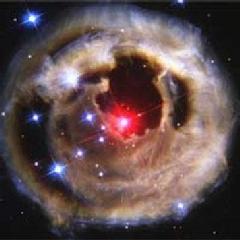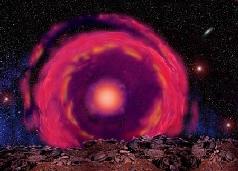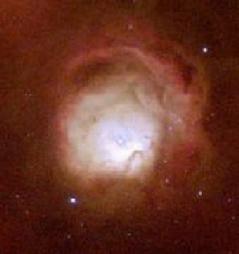Turbulent Changes in the Cosmos (Photos)
(Clearwisdom.net June 19, 2003)
Hubble Captures a Pencil Nebula
June 15, 2003
Remnants from a star that exploded thousands of years ago created a celestial abstract portrait, as captured in this NASA Hubble Space Telescope image of the Pencil Nebula.
Officially known as NGC 2736, the Pencil Nebula is part of the huge Vela supernova remnant, located in the southern constellation Vela. Discovered by Sir John Herschel in the 1840s, the nebula's linear appearance triggered its popular name. The nebula's shape suggests that it is part of the supernova shock wave that recently encountered a region of dense gas.
The region of the Pencil Nebula captured in this image is about three fourths of a light-year across. The Vela supernova remnant is 114 light-years (35 parsecs) across. The remnant is about 815 light-years (250 parsecs) away from our solar system.
The supernova explosion left a spinning pulsar at the core of the Vela region. Based on the rate at which the pulsar is slowing down, astronomers estimate that the explosion may have occurred about 11,000 years ago. The age of the blast, if correct, would imply that the initial explosion pushed material from the star at nearly 22 million miles per hour. As the Vela supernova remnant expands, the speed of its moving filaments, such as the Pencil Nebula, decreases. The Pencil Nebula, for example, is moving at roughly 400,000 miles per hour.
One can also see a bright star in this image, but it has nothing to do with the Pencil Nebula. In fact, astronomers haven't yet measured the distance between this star and the Pencil Nebula.
Supernova Is Forming in Cassiopeia
February 19, 2003
Through a long period of observation, astronomers from Netherlands found out that a star in Cassiopeia will soon explode. Since 1993, astronomers have carried out careful observation on this yellow giant star -- one of the brightest stars in the Milky Way. In 2000, the temperature of this star was found to suddenly drop from 7,000 degrees to 4,000 degrees and at the same time, the star emitted substances. The mass of the ejected material weighs more than 10,000 times that of the earth. This is up to present the strongest substance emission from a star that has been observed by astronomers.
Scientists consider that supernova explosion could occur at any moment and that this explosion might actually have happened and happened a long time ago. We have to note that Cassiopeia lies about 10,000 light-years away.
Mysterious Erupting Star Reverberates Through Space
April 1, 2003
In January 2002, a dull star in an obscure constellation suddenly became 600,000 times more luminous than our Sun, temporarily making it the brightest star in our Milky Way galaxy. The mysterious star has long since faded back to obscurity, but observations by NASA's Hubble Space Telescope of a phenomenon called a "light echo" have uncovered remarkable new features.
This petulant star, called V838 Monocerotis (V838 Mon) is about 20,000 light-years from Earth. The star puts out enough energy in a brief flash to illuminate surrounding dust, like a spelunker taking a flash picture of the walls of an undiscovered cavern. The star presumably ejected the illuminated dust shells in previous outbursts. Light from the latest outburst travels to the dust and then is reflected to Earth.
V838 Mon did not expel its outer layers. Instead, it grew enormously in size, with its surface temperature dropping to temperatures not much hotter than a light bulb. This behavior of ballooning to an immense size, but not losing its outer layers, is very unusual and completely unlike an ordinary nova explosion. The star is so unique it may represent a transitory stage in a star's evolution that is rarely seen. The star has some similarities to highly unstable aging stars called eruptive variables, which suddenly and unpredictably increase in brightness.
Hubble Resolves Dying Planetary Nebulae
May 19, 2003
Planetary nebulae like the Helix are sculpted late in a sun-like star's life by a torrential gush of gases escaping from the dying star. They have nothing to do with planet formation, but got their name because they look like planetary disks when viewed through a small telescope. With higher magnification, the classic "donut-hole" in the middle of a planetary nebula can be resolved.
The above photo shows a striking example of a planetary nebula, NGC 3132, which is also known as the "Eight-Burst" or "Southern Ring" Nebula. NGC 3132 viewed by the Hubble telescope views an expanding cloud of gas, surrounding a dying star. NGC 3132 is nearly half a light year in diameter, and at a distance of about 2000 light years is one of the nearer known planetary nebulae. The gases are expanding away from the central star at a speed of 9 miles per second.
This image of NGC 3132, captured by NASA's Hubble Telescope, clearly shows two stars near the center of the nebula, a bright white one, and an adjacent, fainter companion to its upper right. (A third, unrelated star lies near the edge of the nebula.) The faint partner is actually the star that was ejected. This star is now smaller than our own Sun, but extremely hot. The flood of ultraviolet radiation from its surface makes the surrounding gases glow through fluorescence. The brighter star is in an earlier stage of stellar evolution, but in the future it will probably eject its own planetary nebula.
Sleeping Beauty Galaxy
May 30, 2003
M64 is the famous Black Eye galaxy, sometimes also called the "Sleeping Beauty galaxy". The conspicuous dark structure is a prominent dust feature obscuring the stars behind.
M64 was recently shown to have two counter-rotating systems of stars and gas in its disk: The inner part of about 3,000 light years radius is rubbing along the inner edge of the outer disk, which rotates opposite and extends up to at least 40,000 light years, at about 300 km/sec. This rubbing process is probably the reason for the observed vigorous star formation process, which is currently under way, and can be observed as the blue knots imbedded in the peculiar dust lane on one side of the nucleus. It is speculated that this peculiar disk and dust lane may be caused by material from a former companion which has been accreted but has yet to settle into the mean orbital plane of the disk.
Strongest Supernova Explosion
April 15, 2003
Gamma-ray bursts (GRBs) pose one of the greatest mysteries of modern astronomy. Most astrophysicists think that gamma ray bursts, fantastically energetic flares from deep space, stream from new black holes that form when the cores of massive spinning stars collapse to trigger supernovas.
Scientists have pieced together the key elements of a gamma-ray burst, from star death to dramatic black hole birth, thanks to a March 29, 2003 explosion considered the "Rosetta stone" of such bursts. This telling March 29 burst in the constellation Leo, one of the brightest and closest on record, reveals for the first time that a gamma-ray burst and a supernova -- the two most energetic explosions known in the Universe -- occur essentially simultaneously, a quick and powerful one-two punch. GRB 030329, named after its detection date, occurred relatively close, approximately 2 billion light years away (at redshift 0.1685). The burst lasted over 30 seconds. Scientists say the gamma-ray burst detected on March 29, 2003, was associated with a hypernova, which is more energetic and expands more rapidly than a supernova does.
Hubble Captures a Perfect Storm of Turbulent Gases
May 6, 2003
Resembling the fury of a raging sea, this image actually shows a bubbly ocean of glowing hydrogen gas and small amounts of other elements such as oxygen and sulfur.
The photograph, taken by NASA's Hubble Space Telescope, captures a small region within M17, a hotbed of star formation. M17, also known as the Omega or Swan Nebula, is located about 5,500 light-years away in the constellation Sagittarius. The image is being released to commemorate the thirteenth anniversary of Hubble's launch on April 24, 1990.
The image, roughly 3 light-years across, was taken May 29-30, 1999, with the Wide Field Planetary Camera 2. The colors in the image represent various gases. Red represents sulfur; green, hydrogen; and blue, oxygen.
Dying Stars in Tarantula Nebula
April 29, 2003
Hodge 301, seen in the lower right hand corner of this image, lives inside the Tarantula Nebula in our galactic neighbor, the Large Magellanic Cloud.
This star cluster is not the brightest, or youngest, or most populous star cluster in the Tarantula Nebula. But age has its advantages; many of the stars in Hodge 301 are so old that they have exploded as supernovae. These exploded stars are blasting material out into the surrounding region at speeds of almost 200 miles per second. This high speed ejects are plowing into the surrounding Tarantula Nebula, shocking and compressing the gas into a multitude of sheets and filaments, seen in the upper left portion of the picture.
Hodge 301 contains three red super-giants, stars that are close to the end of
their evolution and are about to go supernova, exploding and sending more shocks
into the Tarantula Nebula.
Also present near the center of the Hubble telescope image are small, dense gas globules and dust columns where new stars are being formed today, as part of the overall ongoing star formation throughout the Tarantula nebula region.
The Most Beautiful Stars
April 28, 2003
Image 1
Planetary nebulae -- remnants of stellar explosions are splendid celestial bodies in the cosmos, but they are still mysteries to astronomers. Although many gas-dust nebulae are rather close to the earth and have been carefully investigated, they still let astronomers feel puzzled.
Image 2
First, what we talked about here are handful abnormal nebulae. They are intensively heated and they contain large amount of ions, that is, charged atoms. Their radiant intensity depends on the amount of atoms that participate in this process and the amount of electrons that are lost. The hot "wind" blew away those special bubbles in the surrounding substances. In the photos taken, some bubbles show themselves as different colorful arcs.
Image 3
What is the source of this kind of atomic emission? It might be young hot stars or some bizarre celestial body hiding in a nebula. How to list these bizarre celestial bodies in the modern picture of the cosmic evolvement? Recently, astronomers carried out extensive observations and found out that the nebulae in four photos of Magellanic Cloud are highly ionized. (The Large Magellanic cloud and the small Magellanic Cloud are two closest companion galaxies of the Milky Way. They are about a few light years away from the earth.)
Image 4
In the first three nebula images, Belgian astronomers identified the origins of the high energy emission including the ultraviolet radiation are the most heated and most gigantic stars (among which are a few double stars). This might be WR-Wolf-Rayet stars, whose brightness are more than 1 to 10 million times of that of the Sun. But their burning can only last a few million years rather than a few billion years. Just like the dead yellow dwarf stars whose mass is more than 20 times that of similar stars and the surface temperature is over 90,000 degree. In the fourth image, the Belgian astronomers were not able to identify the origin of the emission.
Marvelous Spectacle: Hypergiant Erupts
January 9, 2003
Rho Cas (type semiregular) is a hypergiant star and one of the most luminous stars in our galaxy. Eruptions on these very rare, very massive stars produce huge mass ejections evidenced by dramatic spectral changes and optical dimming (an ejection in 2000 amounted to 10,000 Earths worth of material and caused a ~1.5-magnitude drop in visual brightness)
Astronomers are anticipating possible major activity in rho Cas over the next few months and feel that the eruption projected for the coming months may be stronger that the 2000 one.
A Rose Blooming in the Universe
September 23, 2002
Resembling a delicate rose floating in space, the nebula N11A is seen in a new light in a true-colour image taken by the NASA/ESA Hubble Space Telescope. Fierce radiation from massive stars embedded at the centre of N11A illuminates the surrounding gas with a soft fluorescent glow.
N11A lies within a spectacular star-forming region in the Large Magellanic Cloud, a small nearby companion galaxy to our own Milky Way Galaxy, visible from the Southern Hemisphere. This nebula is particularly interesting for astronomers since it is the smallest and most compact nebula in that region and represents the most recent massive star formation event there.
Giant Black Holes Merge
September 4, 2002
Australian and American astronomers have found convincing evidence that black hole mergers do take place, as scientists have long suspected. For instance, in the main view above is the pattern of jet lobes from galaxy NGC326 seen a few years ago. Jets of energy (inset) from the core of radio galaxy NGC326 appear to have changed direction suddenly, interpreted as a result of black holes merging.
Scientists produced a mathematical model showing that a merger between two black holes would impart a change in spin to the larger black hole, causing its spin axis to flip suddenly -- in the space of just a few minutes. In effect, it knocks over the larger black hole by merging with it. Galaxies that produce radio waves in a 'winged' or X-shape may be evidence of this effect.
Although astronomers have known about X-shaped galaxies for a long time, but until now, a convincing explanation had never been found for them.
Galaxies in death waltz spied by Hubble
December 18, 2002
NASA's Hubble Space Telescope is witnessing a grouping of galaxies engaging in a slow dance of destruction that will last for billions of years. The galaxies are so tightly packed together that gravitational forces are beginning to rip stars from them and distort their shapes. Those same gravitational forces eventually could bring the galaxies together to form one large galaxy.
The galactic group is known as Seyfert's Sextet, suggesting that six galaxies are taking part in the deadly dance. There are in fact only four. The small edge-on spiral galaxy in the center of the image is actually five times farther away than the group. An incidental alignment makes it seem like it belongs. The sixth "galaxy" in the sextet, below to the right, is actually a long stream of stars torn from one of the other galaxies.
The main group of galaxies is some 190 million light-years away in the constellation Serpens. It is only 100,000 light-years across, taking up less volume than our Milky Way galaxy.
Their distorted shapes suggest that gravitational forces have reshaped them. The halos around the galaxies indicate that stars have been ripped away. Such large intergalactic collisions usually spark the formation of many stars. But Seyfert's Sextet -- captured by Hubble's Wide Field and Planetary Camera in 2000 -- lacks such young stellar clusters, which appear as bright blue regions in space images. The galaxies will continue to interact. And eventually, billions of years from now, all four may merge and form a single galaxy.
References:
http://hubblesite.org/newscenter/archive/2003/ http://hubblesite.org/gallery/showcase/nebulae/n8.shtml http://www.astronomy.com/Content/Dynamic/Articles/000/000/001/286prhls.asp http://hubblesite.org/newscenter/archive/2002/11/image http://spaceflightnow.com/news/n0301/12hypergiant http://spaceflightnow.com/news/ http://www.obspm.fr/actual/nouvelle/sep02/rose.en.shtml http://www.cnn.com/2002/TECH/space/12/19/hubble.seyfert














